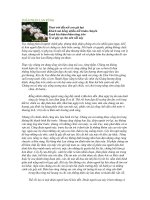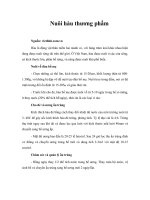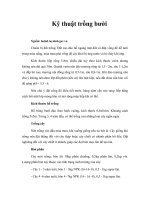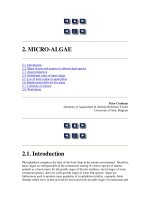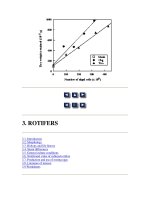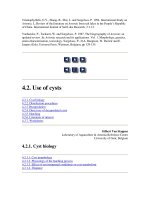Tài liệu Pests around the house pptx
Bạn đang xem bản rút gọn của tài liệu. Xem và tải ngay bản đầy đủ của tài liệu tại đây (51.84 KB, 6 trang )
Pests around the house
Ants - Bats - Bedbugs - Bluebottles - Carpet Beetles - Cockroaches - Death Watch Beetles -
Earwigs - Fleas - Flies - Mice - Moths - Rats - Spiders - Wasps - Woodlice - Woodworm
REMEMBER: This sheet suggests the use of certain
poisons and chemicals to control the pests - these
can be dangerous. Always handle with care and follow
the manufacturer's instructions.
ANTS
The common garden (flying) ant is black, about 3-4 mm long and usually lives in outdoor or
underfloor nests. Swarms of short-lived flying ants emerge to mate in August. Although
garden ants are a nuisance, they are not significant disease carriers.
Pharaoh Ants are reddish in colour and about 2 mm long. They are fairly common in flats and
hotels and spread disease from drains to food. They nest within the building structure and
may well be hard to get at.
Remedy:
Find the nest entrance and pour boiling water over the nest site. Then apply an insecticide
powder. An insecticide lacquer can be applied around door thresholds or wall/floor junctions
where ants run. Ant Bait work so that the ant takes the bait back to the nest, killing the whole
colony after a few days; lay in along where ants run. If you have a Pharaohs infestation, you
may need to contact a local pest control contractors or Environmental Health Department.
BATS
Bats sleep during the day, hanging upside down from the roof rafters or on an outside wall.
Contrary to popular ideas, they do not like belfries as they like drought free locations. Various
types are native to Britain and are usually seen around dusk as they sweep across the sky
catching air borne insects. They cause no harm and under British law, can only be handled by
licensed people.
Remedy:
Law protects all species of bat found in the UK as they are endangered species, it is illegal to
kill or even disturb bats in their roosts. If you have a colony of bats, you should contact the
Nature Conservancy Council, they will arrange for a person to visit the site and advise on the
best course of action.
BEDBUGS
The adult bug is brown and about 3.5 mm long. They feed on blood, they have a needle sharp
bite which pierces the skin of a sleeping human or other warm blooded animal. After it has
finished feeding, the swollen bug will then crawl away to its' hiding place to digest its' meal.
You may also find them under loose wallpaper or in crevices in the furniture.
Remedy:
Try to avoid them in the first place, good cleaning and using clean bed linen will reduce the
chances of an infestation. If you have an infestation, you will need to have the premises,
clothing and bedding sprayed with an insecticide spray, but this is best left to the experts -
either from a local pest control contractors or Environmental Health Department.
BLUEBOTTLES
These large, buzzing flies have shiny metallic blue bodies and are 6 - 12 mm long. They are
attracted to dead meat, on which they lay their eggs as well as feeding. They are often found
around refuse tips, rotting animal matter, dirt and dustbins. They spread disease between
their various landing places.
Remedy:
Keep dustbins clean, with tight lids and away from doors and windows, Keep meat and other
food covered. Use an insecticide dustbin powder. Indoors, use a vapour insecticide strip or
aerosol fly-spray. You could also fit fly screens over kitchen windows.
CARPET BEETLES
The Varied Carpet Beetle is 2 - 4 mm long, like a small, mottled brown, grey and cream
ladybird. The larvae are small and covered in brown hair and tend to roll up when disturbed.
The adult carpet beetle can fly and lives outside the house, feeding on pollen and nectar.
Sometimes they lay their eggs in empty birds' nests, but they also like felt, fabric and
accumulated fluff in buildings. It is the larvae that do the damage, which usually consists of
well-defined round holes along fabric seams.
Remedy:
Check the loft and eaves for old birds' nests or dead birds and remove them. Keep fluff and
debris under control within the house, including the airing cupboards, shelves, floorboards,
carpets and upholstery. Vacuum carpets on a regular basis. Lift carpets and underlay and
clean floors and carpet thoroughly. An insecticide is needed to deal with a bad carpet beetles
infestation and affected items can be sprayed or dusted.
COCKROACHES
Distinguished by their very long, whip-like antennae, flat oval bodies and rapid jerky
movements. The adult German cockroach is brown and about 12 mm long, the Common or
Oriental cockroach is about 20 mm long. They eat all kinds of food - meat, vegetables, fruit,
bread, even paper and leather. Cockroaches thrive around heating ducts and boiler rooms of
large centrally heated buildings and cluster around pipes, stoves and sinks, especially in
humid areas. They taint food with an obnoxious smell and may be carriers of various
diseases, including serious food poisoning.
Remedy:
Control is seldom easy because it is difficult to get the insecticide to the insect. The
insecticide should have sufficient persistence to kill baby cockroaches as they hatch. If this
fails call in your Environmental Health Department or pest control contractor.
DEATH WATCH BEETLE
A woodboring beetle, the grubs eat old hardwood. Adults rarely fly, so infestations are
generally restricted to areas where previous infestations have not been completely eradicated
or where old, infected timber has been introduced. They prefer hardwood, not the softwoods
used in modern softwood house timbers. Grubs live up to ten years inside timber, emerging
as adult (mottled grey/brown) beetles about 7 mm long. They produce a rapid tapping sound
by beating their heads against the wood as a mating call.
Remedy:
Persistent and thorough use of a proprietary woodworm killer will deal with small outbreaks.
Call in a wood preservation company for large infestations.
EARWIGS
Earwigs are easily recognisable by the pair of pinchers at the end of their abdomen. They are
dark reddish-brown, with light brown legs, about 15 mm long. They are primarily nocturnal,
with some species being attracted to lights. They are considered scavengers, eating almost
anything, but some are predatory. They also eat live plants.
They can be found in the homes, but prefer cracks and crevices. Their populations will build
up around foundations. They can produce large populations rather quickly. Earwigs can live in
habitats that also house other insects. Their habitats are environments like mulch, pine straw,
leaf litter, etc.
Remedy:
The removal of their habitats is very important for controlling earwigs .
Vapour strips can be hung around all entry points, windows, doors, plumbing under sinks,
skirting boards etc. Spray can be used in uninhabited areas such as garages and basements.
In addition, spray the area around the outside of the house. Alternatively baits are available
which can be laid down in the general area of infestation.
FLEAS
Their little 2 mm bodies are flattened from side to side and they are well known for their ability
to jump. The tiny white eggs are laid in small batches on fur, hair, feathers or the sleeping
places of the host (human, animal or bird). Adult fleas feed on blood and their bites can cause
intense irritation. The cat flea is the most common and readily bites humans. August and
September is when they are at their peak.
Remedy:
Treat any infested pets with a special veterinary aerosol, powder or shampoo - injections are
now available from vets to protect pets for a period of time. Burn infested bedding and spray
or dust a suitable insecticide into all cracks and crevices in walls and floors. Remove old
birds' nests etc. from around the house.
FLIES
Around 10 mm long, the House Fly is the most common pest in buildings and is found in most
homes. They feed by vomiting saliva on to the food surface, treading it in and sucking up the
resulting liquid! The fly is a health hazard; it passes on dangerous germs from the last place
that it visited - which could have been anywhere from a dustbin to animal droppings!
Remedy:
Scrupulous hygiene and prompt disposal of all rubbish will discourage flies. Keep food
covered and site dustbins away from doors and windows. You can also fit fly screens to doors
and windows.. There are a number of fly-killer aerosols on the market as well as impregnated
plastic strips giving off insecticide vapour.
MICE
Mice are usually detected from their dark coloured droppings as well as noticing damage to
stored food, packaging or woodwork. Mice have a compulsive need to gnaw; electric cables,
water and gas pipes, packaging and woodwork can all be seriously damaged. They climb well
and can squeeze through very small gaps. They contaminate food and can carry many
diseases, particularly food poisoning.
If you live in or near the country and think you have mice, you may have field-mice or other
furry creatures; they cause just as much damage but tend to be less dangerous.
Remedy:
Keep your home mouse-proof, this means blocking all possible routes into the house. While
they can get into a cavity wall or roof space, they will be very hard to eliminate - check that
the structure around all pipes projecting through the outer skin of the house are fully sealed.
Proprietary mouse killers are available for household use and more powerful methods are
available but can only be used by pest control contractors or environmental health
departments.
There are humane mouse traps available. They usually consist of a box that the mouse is
tempted into. Once trapped you simply let the mouse free into an open area a long way from
your home.
MOTHS
The clothes moths have infested many households. Two kinds are common:
• The case-making moth is so called because the caterpillar spins a shelter
case of silk and bits of the material on which it is feeding.
• The webbing clothes moth, the most abundant and injurious species, spins
silky webs as it moves over a piece of material.
The adult moths are probably harmless. The clothes moth stays in dark places and flies very
little. However the female begins to lay eggs, before it is a day old, and lays about 100 in the
7 to 14 days of its life. The soft, white eggs are laid loosely upon the material on which the
larvae are to feed. They are easily dislodged and crushed, so that anything that is regularly
brushed or shaken should not become moth infested. In warm weather the eggs hatch in from
four to eight days. In colder weather, hatching may take as long as three weeks. The larvae
eat furiously for about 40 days before turning into pupae. The pupa stage lasts eight to ten
days in warm weather, and three to four weeks in the winter in a heated building. Eggs,
larvae, and pupae die quickly at low temperatures.
It is the larvae that does the damage to clothes and are about 12 mm long white worms.
Adults are yellow-brown, with narrow wings, about 12 mm long. They eat protein based
material, they have an unusual ability to digest keratin. Keratin is found in woollens, furs, hair,
leathers, hides, feathers, horns and stored meat and dairy products. Clothes moths hardly
ever damage synthetic materials. Keratin is also found in hair, skin and nail tissues. Clothes
moths will damage silk and linens, and synthetics, but it will be incidental, while the larvae are
eating their preferred foods. They particularly damage fabrics stained from oil from human
hair, human sweat, urine, beer, milk, soft drinks and juices.
Remedy:
The first order of business is to clean stored clothes. It is important to identify the source of
infestation. Besides looking where clothes are stored, look around your baseboards for fluff.
At times they can be found in your kitchen and in bird nests. Vacuum very well all the cracks
and crevices of the infested area and spray with a suitable aerosol and place a cloth moth
trap. The old fashion moth balls (with their distinctive smell) can also be used when storing
clothes.
RATS
The Common, or Brown Rat is about 250 mm long and is a creature of habit, living both
above and below ground. The Black Rat (the original plague carrier) is smaller - about 175
mm long and is an agile climber. They breed rapidly and, like mice, need to gnaw constantly.
Brown Rats burrow underground or into soft material; refuse tips, loose soil under sheds and
straw are likely sites. They damage woodwork, plastic and pipes and will sometimes strip
insulation from electric cables by their gnawing (until they met their maker in a flash!). They
spread many diseases including food poisoning. They contaminate more food than they
consume and their urine can pollute stagnant water.
Remedy:
Block off gaps under sheds and move loose piles of wood. Do not encourage rats by leaving
scraps of food out of doors, if you think you have an infestation, stop feeding the birds as you
could be feeding the rats. Poison is available as proprietary, ready-mixed bait. Serious or
persistent infestations should be dealt with by a pest control contractors or Environmental
Health Department.
SPIDERS
(if you call him a pest !)
House spider help us by eating a large number of household pests. None of the native British
types are poisonous to man. The reason why they are often found in baths and sinks is that
they cannot climb smooth surfaces, so if they fall in, they are stranded.
Remedy:
To remove a spider there is no need to kill it. Simply place a carton over it, then slip a piece of
thin cardboard between the carton and the surface to form a lid. Then take the sealed
container out of the building and let the spider go.
WASPS
Around 10-20 mm long. The queen wasp is larger and hibernates over winter, making a new
nest in the spring in which she lays her eggs. If annoyed or threatened, wasps will sting. They
can come into the house where they are attracted to sweet things (jams, fruit etc.).
Remedy:
You can fit screens over windows if wasps are a major problem. Individual wasps can be
killed with a fly-killer aerosol. The old-fashioned method of filling ajar one-third full with jam
and water, covered by a punctured paper lid will drown them. If you find a wasps nest in a
wall or bank, and are brave, apply a powder insecticide product from a puffer pack labelled for
wasp nest control. Thoroughly spray nests in roofs or sheds with an insecticide. This can be
dangerous as the wasps can become angry and attack any animal (including humans) in the
area and is best performed by professionals. Some local councils will do it for free.
WOODLICE
